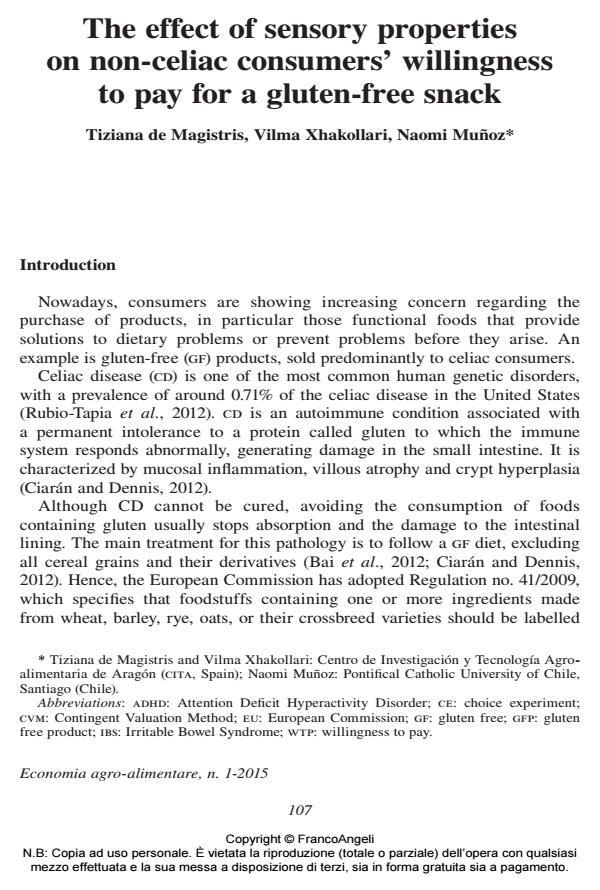The effect of sensory properties on non-celiac consumers’ willingness to pay for a gluten-free snack
Journal title ECONOMIA AGRO-ALIMENTARE
Author/s Tiziana de Magistris, Wilma Xhakollari, Naomi Munoz
Publishing Year 2015 Issue 2015/1
Language English Pages 12 P. 107-118 File size 104 KB
DOI 10.3280/ECAG2015-001006
DOI is like a bar code for intellectual property: to have more infomation
click here
Below, you can see the article first page
If you want to buy this article in PDF format, you can do it, following the instructions to buy download credits

FrancoAngeli is member of Publishers International Linking Association, Inc (PILA), a not-for-profit association which run the CrossRef service enabling links to and from online scholarly content.
The aim of our exploratory study is to assess the effects of organoleptic attributes on willingness-to-pay (wtp) values for gluten-free (gf) snacks assessed by non-celiac consumers. This study was undertaken using data from a hypothetical experiment conducted in Spain. We find that non-celiac consumers value the texture of gf snacks and that this is the only attribute to have a significant positive effect on wtp. The descriptive results show that consumers believe that gf products are expensive, but that they do not present secondary effects; they are not considered either a fashion or a fraud. Moreover, the participants followed a healthy diet, which consisted of fruits and vegetables and foods rich in minerals and vitamins.
Keywords: Gluten-free, willingness to pay, no-celiacs
Jel codes: C10; C93; D12
- Arendt, E.K., O’ Brien, C., Schober, T., Gormley, T. & Gallagher, E. (2002). Development of gluten-free cereal products. Farm and Food, 12, 21-27.
- Arendt, E.K., Morrissey, A., Moore, M.M. & Dal Bello, F. (2008). Gluten-free breads. In E.K. Arendt & F. Dal Bello (Eds). Gluten-free cereal products and beverages. London: Academic Press, pp. 289-319. DOI: 10.1016/b978-012373739-7.50015-0
- Bai, J.C; Fried, M., Corazza, G.R., Schuppan, D., Farthing, M., Catassi, C., Greco, L., Cohen, H., Ciacci, C., Fasano, A., González, A., Krabshuis, J.H.
- & LeMair, A. (2012). Celiac Desease, World Gastroenterology Organisation Global Guidelines. Available at: www.worldgastroenterology.org/assets/export/userfiles/2012_Celiac%20Disease_long_FINAL.pdf DOI: 10.1097/mcg.0b013e31827a6f83
- Bogue, J. & Sorenson, D. (2008). The marketing of gluten free cereal products. En Food Science and Technology (Arendt, E. and Dal Bello, F.). Gluten-Free Cereal Products and Beverages, 393-411. Academic Press. DOI: 10.1016/b978-012373739-7.50019-8
- Carlsson, F., Kataria, M., Krupnick, A., Lampi, E., Löfgren, A., Qin, P., Sterner & T., Chung, S. (2010). The Truth, the Whole Truth, and Nothing but the Truth: A Multiple Country Test of an Oath Script. Journal of Economic Behaviour & Organization, 89: 105-121. DOI: 10.1016/j.jebo.2013.02.003
- Ciarán, K. & Dennis, M. (2012). Patient information: Celiac disease in adults. Recovered from url: www.uptodate.com/contents/celiac-disease-in-adultsbeyond-the-basics.
- De Magistris, T. & Pascucci, S. (2014). The effect of the solemn oath script in hypothetical choice experimentsurvey: A pilot study. Economics Letters, 123, 252-255. DOI: 10.1016/j.econlet.2014.02.016
- Gray, J., Armstrong, G. & Farley, H. (2003). Opportunities and contrains in the functional food market. Nutrition & Food Science, 33, 213-218. DOI: 10.1108/00346650310499730
- Green, P.H. & Cellier, M.D.B. (2007). Celiac disease. The New England Journal of Medicine, 357, 1731-1743.
- Grunert, K.G., Bech-Larsen, T. & Bredahl, L. (2000). Three issues in consumer quality perception and acceptance of dairy products. International Dairy Journal, 10, 575-584. DOI: 10.1016/s0958-6946(00)00085-6
- Instituto Aragonés de Estadística (iaest) (2010). Available at www.aragon.es/iaest(accessed on 15 abril 2013). Jacquemet, N., Jame, A.G., Luchini, S. & Shogren, J.F. (2011). Social psychology and environmental economics: a new look at ex-ante corrections of biases preference evaluation. Environmental Resource Economy, 48, 413-433. DOI: 10.1007/s10640-010-9448-4
- Laureati, M., Giussani, B. & Pagliarini, E. (2012). Sensory and hedonic perception of gluten-free bread: Comparison between celiac and non-celiac subjects. Food Research International, 46, 326-333. DOI: 10.1016/j.foodres.2011.12.020
- McFadden, D. (1974). Conditional Logit Analysis of Qualitative Choice Behavior.
- In P. Zarembka (Ed.), Frontiers in econometrics. New York: Academic Press, pp. 105-142.
- Olsson, C., Hornell, A., Ivarsson, A. & Syder, Y.M. (2008). The everyday life of adolescent coeliacs: Issue of importance for compliance with gluten-free diet. Journal of Human Nutrition and Dietetics, 21(4), 359-367. DOI: 10.1111/j.1365-277x.2008.00867.x
- ProChile España. (2013). Tendencias del Mercado, El consumo de alimentos sin gluten en España. ProChile España. Recovered from url: www.prochile.gob.cl/wpcontent/blogs.dir/1/files_mf/1378322789Espana_Tendencia_sin_gluten_2013.pdf.
- Peryam, D.R. & Girardot, N.F. (1952). Advanced taste test method. Food Engineering, 24(7), 58-61, 194.
- Richardson, N., Macfie, H.J.H. & Sheperd, R. (1994). Consumer attitudes to meat eating. Meat Science, 36, 57-65. DOI: 10.1016/0309-1740(94)90033-7
- Rubio-Tapia, A., Ludvigsson, J.F., Brantner, T.L., Murray, J.A. & Everhart, J.E. (2012). The prevalence of celiac disease in the United States. The American Journal of Gastroenterology, 107(10), 1538-44.
- Urala N. & Lähteenmäki, L. (2004), Attitudes behind consumers’ willingness to use functional foods. Food Quality and Preferences, 15, 793-803. DOI: 10.1016/j.foodqual.2004.02.008
- Celiac and non-celiac consumers' experiences when purchasing gluten-free products in Italy Vilma Xhakollari, Maurizio Canavari, in ECONOMIA AGRO-ALIMENTARE 1/2019 pp.29
DOI: 10.3280/ECAG2019-001003 - Recent strategies for tackling the problems in gluten-free diet and products Ilkem Demirkesen, Berrin Ozkaya, in Critical Reviews in Food Science and Nutrition /2022 pp.571
DOI: 10.1080/10408398.2020.1823814 - Why people follow a gluten-free diet? An application of health behaviour models Vilma Xhakollari, Maurizio Canavari, Magda Osman, in Appetite 105136/2021 pp.105136
DOI: 10.1016/j.appet.2021.105136 - Conceptualizing “free-from” food consumption determinants: A systematic integrative literature review focused on gluten and lactose Mariarosaria Savarese, Wendy Wismer, Guendalina Graffigna, in Food Quality and Preference 104170/2021 pp.104170
DOI: 10.1016/j.foodqual.2020.104170 - Are gluten-free products healthy for non-celiac consumers? How the perception of well-being moderates gluten-free addiction Cristina Zerbini, Francesca De Canio, Elisa Martinelli, Beatrice Luceri, in Food Quality and Preference 105183/2024 pp.105183
DOI: 10.1016/j.foodqual.2024.105183 - Celiac Disease and Non-Celiac Gluten Sensitivity Tiziana de‐Magistris, Hind Belarbi, Wajdi Hellali, (ISBN:978-953-51-3177-9)
- Factors affecting consumers' adherence to gluten-free diet, a systematic review Vilma Xhakollari, Maurizio Canavari, Magda Osman, in Trends in Food Science & Technology /2019 pp.23
DOI: 10.1016/j.tifs.2018.12.005
Tiziana de Magistris, Wilma Xhakollari, Naomi Munoz, The effect of sensory properties on non-celiac consumers’ willingness to pay for a gluten-free snack in "ECONOMIA AGRO-ALIMENTARE" 1/2015, pp 107-118, DOI: 10.3280/ECAG2015-001006